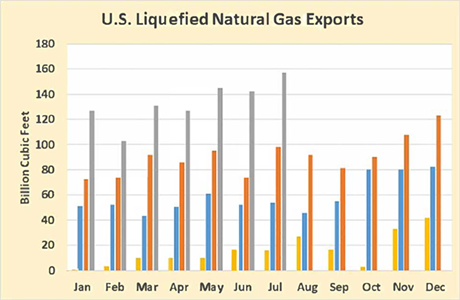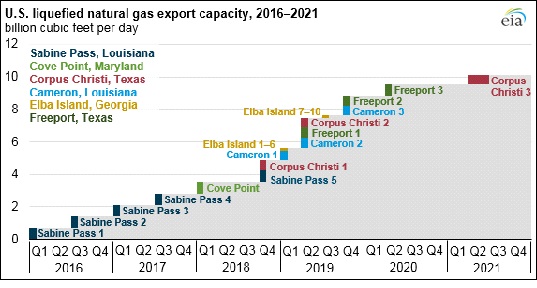Liquefied natural gas exports expand propane supply
In this week’s Trader’s Corner, we are going to look at the rise in U.S. liquefied natural gas (LNG) exports. Why is this important to propane retailers? The increase in LNG export volumes allows the production of more natural gas. More natural gas production means increased propane supplies.
Increasing propane supplies overwhelmed propane domestic demand and exports, causing a build-up in inventory that has driven prices lower this year. The expansion of LNG exports will allow for corresponding increases in natural gas and thus propane production. If propane demand doesn’t keep up, the likely outcome is more downward pressure on propane prices. Demand has struggled to keep up with supply this year, and the result has been that propane’s relative value to crude has sunk to five-year lows for this time of year.
The chart below shows U.S. LNG exports through July of this year (in gray).
U.S. LNG exports have been rising rapidly since 2016. The United States has an abundance of natural gas, but industry growth had been limited by demand in North America due to the necessity of pipeline transportation. However, liquefaction allows export by ship, opening up the entire world to U.S. natural gas.
In July, U.S. LNG exports were 157 billion cu. ft. In all of 2016, LNG exports were only 187 billion cu. ft. Last year’s total was 1,083 billion cu. ft. Through July, this year’s total has already reached 931 billion cu. ft.
The next table provided is from a Dec. 10, 2018 report by the Energy Information Administration, showing LNG capacity and expansions.
At that time, capacity was expected to reach 10 billion cu. ft. per day or about 300 billion cu. ft. per month by mid-2021. Capacity at the end of this year was expected to increase to 8.9 billion cu. ft. per day when that report was released. That would represent the potential to increase LNG exports by around 70 percent.
Over 80 percent of propane supply comes from natural gas processing. Next year, the growth in natural gas supply will slow, continue as the capacity to export more LNG grows. In addition, more U.S. electrical generation is converting from coal to natural gas, which should support more natural gas production.
If there was such a thing as drilling a propane production well, there probably wouldn’t be much of that going on given the current low value. Wells are drilled for natural gas and crude, and propane comes along for the ride. The only propane-related drilling is going to be to make more propane storage wells as supply continues to outpace demand. To avoid more propane in storage, global demand for U.S. propane must increase, and the capacity to export propane must continue to grow with supply.
Call Cost Management Solutions today for more information about how Client Services can enhance your business at (888) 441-3338 or drop us an email at info@propanecost.com.


















